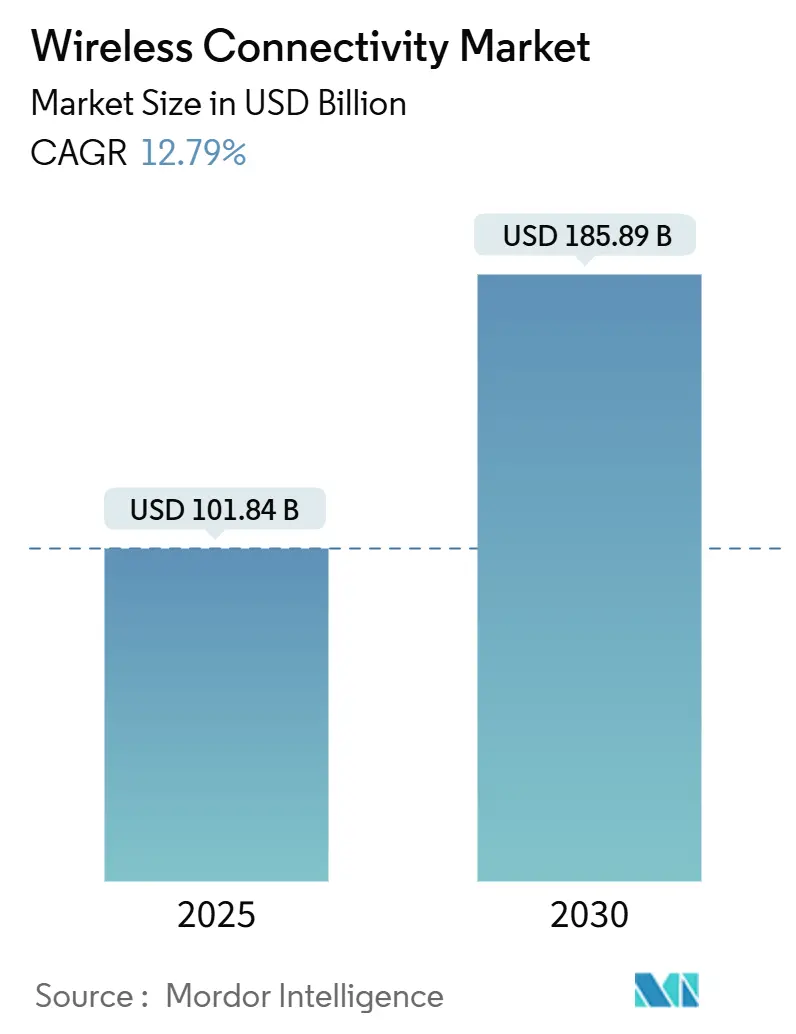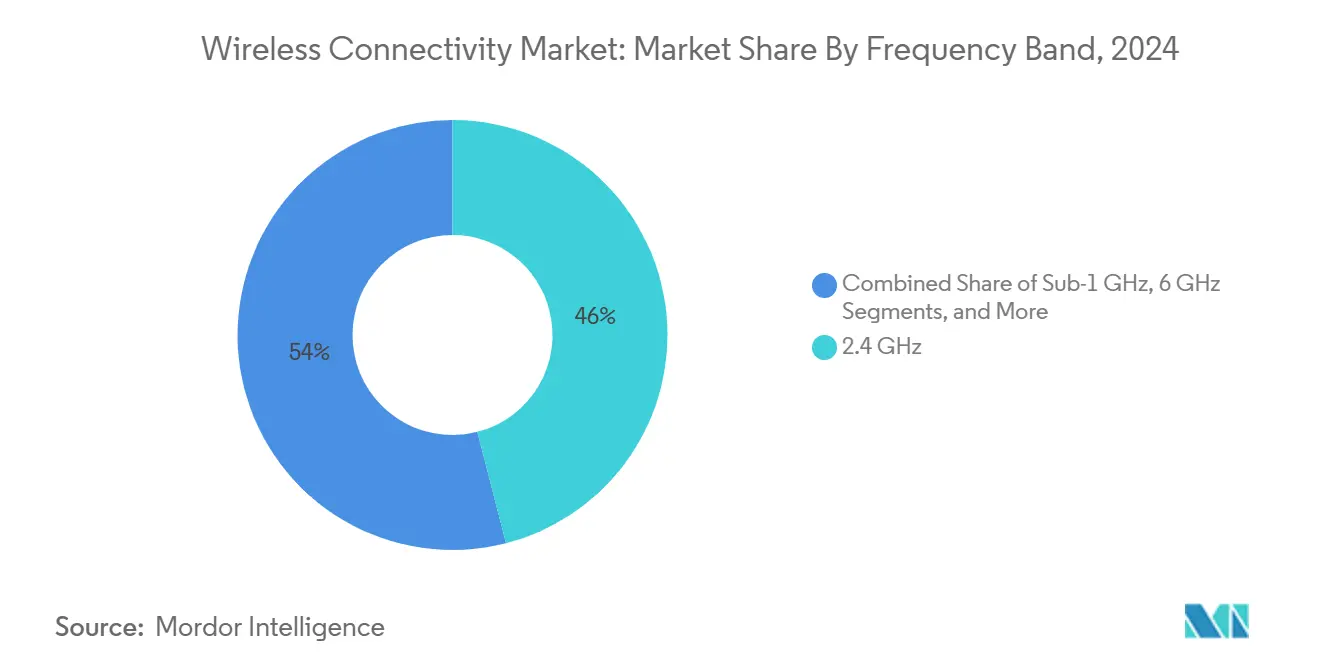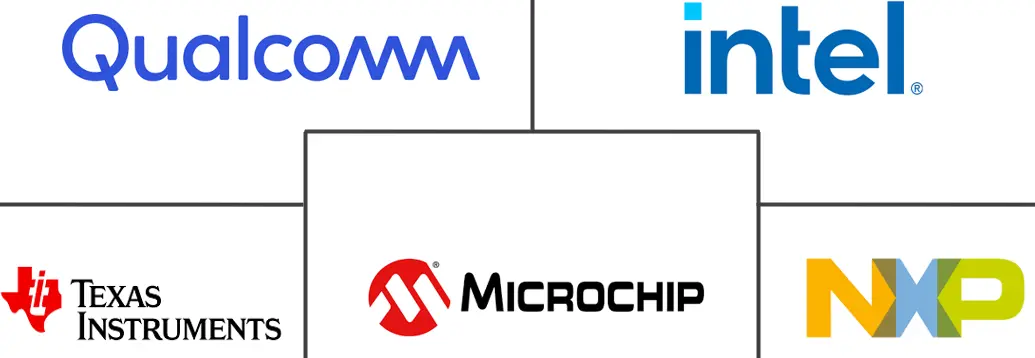Wireless Connectivity Market Size and Share

Wireless Connectivity Market Analysis by Mordor Intelligence
The wireless connectivity market reached USD 101.84 billion in 2025 and is on course to attain USD 185.89 billion by 2030, translating into a 12.79% CAGR during the forecast window.[1]Wi-Fi Alliance, “Certified for Wi-Fi 7,” wi-fi.org Uptake accelerates as organizations modernize operations with cloud, artificial intelligence, and edge computing workloads that demand low-latency, always-available links. The shift is supported by a sharp rise in Internet-of-Things (IoT) endpoints, wider 5G coverage, and early commercial availability of Wi-Fi 7 access points. Semiconductor vendors now embed AI acceleration directly in connectivity chipsets, enabling local traffic classification, power management, and anomaly detection that improve user experience while lowering operating costs. Supply-chain participants are responding with software-defined radios and modular gateways that handle multiple protocols in a single design. Meanwhile, public-sector investment in rural broadband and open-roaming city networks enlarges addressable demand, creating new deployment models for equipment makers and managed service providers.
Key Report Takeaways
- By technology, Wi-Fi led with 42% revenue share in 2024, while LPWAN is projected to expand at a 19.4% CAGR to 2030.
- By end-user industry, consumer electronics accounted for 38% share in 2024; smart infrastructure and buildings are advancing at a 16.2% CAGR through 2030.
- By frequency band, the 2.4 GHz segment held 46% wireless connectivity market share in 2024, whereas the 6 GHz band is forecast to grow at a 19% CAGR between 2025 and 2030.
- By device type, smartphones and tablets captured 38% share of the wireless connectivity market size in 2024, while industrial IoT sensors are poised to rise at a 16.5% CAGR to 2030.
- By geography, North America led with a 34% share in 2024; Asia Pacific is projected to record a 14.7% CAGR from 2025 to 2030.[2]GSMA, “The Mobile Economy 2025,” gsma.com
Global Wireless Connectivity Market Trends and Insights
Drivers Impact Analysis
| Driver | ( ~ )% Impact on CAGR Forecast | Geographic Relevance | Impact Timeline |
|---|---|---|---|
| Surge of Wi-Fi 6/6E/7 chipsets in consumer and industrial IoT | +2.8% | Global, strongest in North America, Europe, Asia Pacific | Medium term (2-4 years) |
| Expansion of LPWAN modules for smart-meter roll-outs | +2.1% | Europe and North America utilities; global follow-through | Long term (≥ 4 years) |
| Private 5G and Wi-Fi co-existence driving multi-radio gateways | +1.9% | North America, EU enterprises, APAC manufacturing hubs | Medium term (2-4 years) |
| Government-funded open-roaming city networks | +1.4% | Europe, North America urban centers, select APAC cities | Long term (≥ 4 years) |
| AI-driven self-optimising wireless networks in factories | +1.7% | Germany, China, United States manufacturing corridors | Medium term (2-4 years) |
| Millimeter-wave backhaul for rural fixed-wireless access | +1.6% | Rural regions worldwide, notably Australia, India, United States | Long term (≥ 4 years) |
| Source: Mordor Intelligence | |||
Surge of Wi-Fi 6/6E/7 Chipsets in Consumer and Industrial IoT
Intel reports more than 5,000 commercial devices shipping with 6 GHz support, and over 1,200 products are already certified for Wi-Fi 7, according to the Wi-Fi Alliance. Broadcom surpassed 1 billion cumulative Wi-Fi 6/6E chipset shipments, highlighting mainstream acceptance across laptops, smartphones, and enterprise access points. Wider 320 MHz channels double theoretical throughput compared with Wi-Fi 6, while multi-link operation allows traffic to steer simultaneously across 5 GHz and 6 GHz, cutting latency in factory automation to sub-millisecond levels. As manufacturers upgrade plants for predictive maintenance and machine vision workloads, deterministic wireless performance becomes indispensable. The resulting refresh cycle lifts demand for network analytics software that verifies service-level metrics in real time, creating a multiplier effect throughout the wireless connectivity market.
Expansion of LPWAN Modules for Smart-Meter Roll-outs
Utility providers accelerate rollout of cellular NB-IoT and unlicensed LoRa devices to meet regulatory mandates and operational efficiency targets. Yorkshire Water crossed 1.3 million connected meters, while Thames Water exceeded 1 million endpoints in service. Installations demonstrate reliable 10-year battery life and wide-area coverage beyond 10 kilometers in rural terrain. These characteristics lower the total cost of ownership compared with legacy reading methods and allow real-time usage analytics that support dynamic tariff models. European and North American frameworks requiring interval data collection extend LPWAN demand into the next decade, reinforcing the long-term growth outlook for the wireless connectivity market.
Private 5G and Wi-Fi Co-existence Driving Multi-Radio Gateways
Enterprises increasingly deploy hybrid architectures that pair private 5G for time-sensitive tasks with Wi-Fi 6E/7 for broadband data. Ericsson’s private 5G deployment in Istres, France, enables mobile video surveillance and real-time asset monitoring at a lower cost than fiber.[3]Ericsson, “14 km 5G mmWave trial,” ericsson.com Such sites rely on gateways that integrate cellular, Wi-Fi, and often Ethernet backhaul, with embedded traffic-steering algorithms that assure quality of service for critical applications. The need for seamless roaming between radio domains opens revenue streams for software-defined networking stacks and security policy managers that oversee heterogeneous links.
Government-Funded Open-Roaming City Networks
Public authorities adopt open-roaming to deliver frictionless connectivity for citizens and visitors. The Wireless Broadband Alliance reports 81% of surveyed executives planning deployments in the next three years. Rome’s EUR 97.7 million #Roma5G program illustrates scale, adding 2,200 small cells and 850 public Wi-Fi access points to serve digital services ranging from traffic optimisation to environmental sensing.[4]Boldyn Networks, “Rome #Roma5G infrastructure launch,” boldyn.com Standardised authentication eliminates frequent log-ins and paves the way for seamless integration of private 5G and municipal IoT networks. City funding models that pool broadband stimulus grants, tower concessions, and ad-supported Wi-Fi create sustainable demand across the wireless connectivity market.
Restraints Impact Analysis
| Restraint | ( ~ )% Impact on CAGR Forecast | Geographic Relevance | Impact Timeline |
|---|---|---|---|
| Fragmented global spectrum policy slowing Wi-Fi 7 adoption | -1.8% | Uneven regulation across Americas, EMEA, Asia Pacific | Medium term (2-4 years) |
| Persistent Bluetooth security exploits in medical wearables | -1.2% | Healthcare markets in North America, Europe | Short term (≤ 2 years) |
| Rising silicon costs tied to advanced-node scarcity | -1.4% | Global semiconductor supply chain | Short term (≤ 2 years) |
| EMC compliance hurdles for UWB in automotive cabins | -0.9% | Automotive sectors worldwide, strongest in Europe, North America | Medium term (2-4 years) |
| Source: Mordor Intelligence | |||
Fragmented Global Spectrum Policy Slowing Wi-Fi 7 Adoption
Only 63 countries have opened some portion of the 6 GHz band for unlicensed use, creating disparities that complicate device certification. Manufacturers must offer regional variants or disable 6 GHz support, raising bill-of-materials cost and elongating product roadmaps. Several regulators explore shared models between cellular and Wi-Fi interests, prolonging policy debates and delaying equipment orders. Enterprises with global footprints postpone refresh cycles until regulatory clarity emerges, moderating near-term revenue in the wireless connectivity market.
Persistent Bluetooth Security Exploits in Medical Wearables
Researchers disclosed BLUFFS and Breaktooth exploits that allow session hijacking and malicious command injection across Bluetooth versions 4.1 to 5.2. FDA coexistence testing has surfaced insufficient encryption practices in numerous medical devices, forcing vendors to redesign architectures and undergo lengthy recertification. Healthcare providers remain cautious, slowing large-scale deployments of connected insulin pumps, smart patches, and neuromuscular stimulators.
Segment Analysis
By Technology: LPWAN Drives Next-Generation Infrastructure
LPWAN shipments accelerate as utilities install remote-read meters and cities deploy environmental sensors. Yorkshire Water’s rollout, paired with similar projects in France and the United States, demonstrates that battery-powered NB-IoT and LoRa endpoints can operate maintenance-free for a decade. The wireless connectivity market size for smart-meter LPWAN modules is forecast to climb steadily through 2030 as regulators mandate hourly consumption data. Wi-Fi retains primacy in homes and workplaces because of its cost-per-bit advantage and backward compatibility with billions of existing devices. While Bluetooth remains a short-range mainstay, channel-sounding enhancements scheduled in the 2025 specification will add centimeter-level accuracy, opening automotive and medical use cases. Cellular 5G continues to expand through private network licences that replace wired field buses on factory floors. Vendors differentiate through converged chipsets that run Wi-Fi 7, Bluetooth LE, and Thread on a single silicon package, lowering design complexity for device makers.
Convergence reshapes procurement: enterprises increasingly issue requests-for-proposal that seek a unified management plane across Wi-Fi access points, small-cell radios, and LPWAN gateways. Software providers respond with cloud dashboards that analyse spectrum occupancy, pre-emptively mitigate interference, and segment traffic via zero-trust policies. Over the next five years this integrated approach will define competitive advantage within the wireless connectivity market.

Note: Segment shares of all individual segments available upon report purchase
By End-user Industry: Smart Infrastructure Transforms Connectivity Demand
Consumer electronics remains the volume anchor, driven by nearly 1.4 billion annual smartphone shipments and rapid turnover cycles. Yet smart-infrastructure projects show the fastest expansion as municipalities digitise transport, waste, and lighting assets. Rome’s #Roma5G project, funded at €97.7 million, exemplifies how blended Wi-Fi, 5G, and IoT networks support public safety, tourism, and environmental stewardship. Industrial customers deploy private 5G and Wi-Fi 7 to enable cordless robotics, machine vision inspection, and augmented-reality maintenance. Automotive platforms integrate three radios—UWB for secure keyless entry, Wi-Fi for infotainment, and cellular V2X for situational awareness—setting performance baselines that ripple throughout supplier chains.
Edge artificial intelligence elevates bandwidth requirements. Smart buildings now embed inference engines in HVAC controllers that adjust air flow based on occupant density, consuming steady uplink capacity for telemetry. Hospitals trial low-power tags that wirelessly track medical equipment within 1 meter accuracy, reducing search time and patient-room disruption. These multi-tenant environments benefit from deterministic latency and roaming assurances, reinforcing investment in the wireless connectivity market.
By Frequency Band: 6 GHz Emergence Reshapes Spectrum Utilisation
The legacy 2.4 GHz band remains indispensable for backward compatibility, but congestion, packet collisions, and growing IoT chatter erode throughput. CableLabs modelling warns that demand within 6 GHz Wi-Fi channels could saturate urban apartment blocks by 2028 unless network planners adopt automatic frequency coordination and edge analytics. Despite policy fragmentation, shipments of 6 GHz-capable devices climbed 66% year-over-year in 2024. Enterprises migrating to Wi-Fi 7 request 320 MHz channel operation to guarantee data rates above 5 Gbps for augmented-reality design suites and multi-stream video collaboration. Millimeter-wave, while high cost, is gaining traction for rural broadband thanks to demonstrated gigabit-class links at 14 kilometers. The blend of sub-1 GHz LPWAN, mid-band Wi-Fi, and high-band 5G supports a layered spectrum strategy that balances coverage, capacity, and cost in the wireless connectivity market.

Note: Segment shares of all individual segments available upon report purchase
By Device Type: Industrial IoT Sensors Drive Enterprise Transformation
Smartphones and tablets still capture the largest unit share, yet industrial IoT sensor nodes represent the fastest growth vector as manufacturers digitise production. New chipsets combine micro-controllers with Wi-Fi 7 and Bluetooth LE radios, lowering bill-of-materials and easing secure firmware updates across tens of thousands of sensors. Wearables expand beyond fitness tracking; smart rings posted 88.4% shipment growth in 2023, demonstrating an appetite for discreet form factors. In homes, tri-band Wi-Fi 7 gateways with embedded AI inference offload voice assistants, preserving privacy and reducing cloud bandwidth. Automotive platforms layer multiple wireless links, forcing original-equipment manufacturers to re-architect wiring harnesses around zonal gateways that aggregate traffic through a single Ethernet backbone. Healthcare devices integrate secure elements and firmware attestation to meet evolving FDA guidelines after a series of Bluetooth vulnerabilities.
The interplay of edge compute and connectivity reshapes business models: device makers bundle subscription analytics that interpret sensor data in real time, locking in recurring revenue. This services orientation contributes to the long-run expansion of the wireless connectivity market.
Geography Analysis
North America accounts for 34% of global revenue, sustained by early 5G adoption, enterprise Wi-Fi 7 upgrades, and favourable spectrum policy, according to GSMA. Operators pivot to fixed-wireless access as a rapid alternative to fibre, particularly in suburban pockets where trenching costs remain high. The United States also pilots Citizens Broadband Radio Service private-network models for manufacturing and logistics campuses.
Asia Pacific records the strongest momentum with a 14.7% CAGR to 2030, according to GSMA. China leads global private 5G installations across steel, ports, and mining, while India expects 30 million fixed-wireless 5G subscribers by 2027. Government grants in Japan and South Korea cover rooftop Wi-Fi for tele-education and tele-health in remote islands, expanding the wireless connectivity market size there.
Europe focuses on harmonised open-roaming and green-building regulations that encourage energy-aware wireless deployments. Rome’s citywide project demonstrates how shared infrastructure lowers ownership cost for carriers and municipal agencies. Stand-alone 5G adoption, however, trails other developed regions, with just 2% availability in 2024.
The Middle East and Africa see accelerating small-cell investments, led by Saudi Arabia where the 5G small-cell segment is projected to compound at 40.9% per year to 2030 ABN Newswire. Rural millimeter-wave pilots in Australia and South Africa test long-reach beamforming, showing promise for last-mile connectivity. Latin America experiences growing interest in low-earth-orbit satellites as backhaul, complementing terrestrial Wi-Fi hotspots in underserved communities.

Competitive Landscape
Market concentration remains moderate as incumbent semiconductor houses compete with specialised start-ups. Qualcomm and MediaTek dominate smartphone modems, yet MediaTek’s leadership in the sub-USD 250 tier gave it a 29.2% share of 5G handsets in Q1 2024. Qualcomm diversifies into automotive by acquiring Autotalks, adding V2X capabilities to its Snapdragon Digital Chassis offering. Broadcom leads enterprise Wi-Fi, surpassing 1 billion Wi-Fi 6/6E chips shipped and launching the VeloSky platform that unifies fibre, cellular, and satellite management for service providers.
Synaptics focuses on IoT by releasing the Veros Wi-Fi 7 family with tri-band support and AI-driven resource management. Motorola Solutions strengthened mission-critical mesh capabilities through its USD 4.4 billion purchase of Silvus Technologies, according to Motorola Solutions. Infrastructure convergence drives large transactions, exemplified by Zayo’s USD 4.25 billion acquisition of Crown Castle’s fibre business, adding 90,000 route-miles to meet AI data-centre backhaul needs.
R&D spending intensifies: MediaTek invested NTD 35.8 billion in Q1 2025 to advance AI, 5G, and Wi-Fi 7 chips, according to MediaTek. Vendors integrate machine-learning engines for self-healing networks, viewing software analytics as a source of differentiation that commands premium margins in the wireless connectivity market.
Wireless Connectivity Industry Leaders
-
Qualcomm Incorporated
-
Intel Corporation
-
Texas Instruments Inc.
-
NXP Semiconductors N.V.
-
Microchip Technology Inc.
- *Disclaimer: Major Players sorted in no particular order

Recent Industry Developments
- June 2025: Qualcomm completed acquisition of Autotalks to expand V2X portfolio.
- February 2025: Vodafone and Three UK finalised a GBP 16 billion merger, creating a 27 million-subscriber entity.
- June 2025: STMicroelectronics began volume production of turnkey Bluetooth/Wi-Fi modules co-developed with Qualcomm.
- May 2025: Motorola Solutions acquired Silvus Technologies for USD 4.4 billion
Research Methodology Framework and Report Scope
Market Definitions and Key Coverage
Our study defines the wireless connectivity market as the total annual revenue generated from integrated radio chipsets, modules, and embedded SoCs that enable untethered data transfer over Wi-Fi, Bluetooth, Zigbee, NFC, ultra-wideband, LPWAN families (LoRa, NB-IoT, Sigfox), and licensed cellular standards up to 5G. Purely service-based connectivity fees are left outside the scope; this is where Mordor Intelligence keeps the boundary clear.
Scope Exclusion: Passive RFID tags and wired back-haul equipment are excluded.
Segmentation Overview
- By Technology
- Wi-Fi
- Bluetooth
- Zigbee
- NFC
- Cellular (4G/5G)
- LPWAN (LoRa, NB-IoT, Sigfox)
- UWB
- Other Technologies
- By End-user Industry
- Consumer Electronics
- Automotive
- Industrial and Manufacturing
- Healthcare and Medical Devices
- Energy and Utilities
- Smart Infrastructure and Buildings
- Other End-user Industries
- By Frequency Band
- Sub-1 GHz
- 2.4 GHz (legacy Wi-Fi/BLE devices)
- 6 GHz (Wi-Fi 6E / Wi-Fi 7)
- By Device Type
- Smartphones and Tablets
- Industrial IoT Sensors
- Wearables
- Smart Home Devices
- Automotive Systems
- Healthcare Devices
- By Geography
- North America
- United States
- Canada
- Mexico
- South America
- Brazil
- Argentina
- Rest of South America
- Europe
- Germany
- United Kingdom
- France
- Italy
- Spain
- Russia
- Rest of Europe
- Asia Pacific
- China
- India
- Japan
- South Korea
- ASEAN
- Rest of Asia Pacific
- Middle East and Africa
- Middle East
- Saudi Arabia
- United Arab Emirates
- Turkey
- Rest of Middle East
- Africa
- South Africa
- Nigeria
- Kenya
- Rest of Africa
- Middle East
- North America
Detailed Research Methodology and Data Validation
Primary Research
Mordor analysts spoke with chipset vendors, IoT gateway OEM engineers, mobile-network planners, and facility IT heads across North America, Asia-Pacific, and Europe. These conversations validated penetration assumptions for Wi-Fi 6E routers, 5G RedCap modules, and dual-band smart-meter roll-outs, and they flagged region-specific subsidy impacts that raw desk data misses.
Desk Research
We begin by scraping trusted open datasets from the International Telecommunication Union, GSMA Intelligence, FCC, Eurostat, China's MIIT, and peer-reviewed IEEE papers to size connected-device pools and spectrum allocations. Company 10-Ks, investor decks, and trade-association dashboards (WBA, Bluetooth SIG) help our analysts track average selling prices and node transitions. Subscription resources such as D&B Hoovers and Dow Jones Factiva then let us cross-check vendor revenue splits, while import-export leads from Volza reveal LPWAN module flows into utility roll-outs. The items named here illustrate our desk inputs; several additional sources were also tapped for confirmation.
Market-Sizing & Forecasting
A top-down build starts with installed device bases, mobile-subscription counts, and semiconductor content per node. These volumes are married with sampled ASPs to create revenue pools, which are then sanity-checked through supplier roll-ups and channel checks. Key variables include 6 GHz spectrum adoption rates, LPWAN meter deployments, smartphone replacement cycles, macroeconomic GDP outlooks, and IoT endpoint growth curves. Multivariate regression combined with scenario analysis produces five-year forecasts, while gap pockets in bottom-up samples are bridged with weighted averages from adjacent geographies.
Data Validation & Update Cycle
Every draft model passes two independent analyst reviews, variance thresholds trigger re-contacts with earlier respondents, and macro indicators are refreshed quarterly. We refresh the full dataset annually and release interim flashes if spectrum policy or chipset pricing shifts materially.
Why Our Wireless Connectivity Baseline Commands Reliability
Published estimates often diverge because firms pick different inclusion rules, price stacks, and refresh cadences.
Key gap drivers include whether modules inside consumer devices are counted separately, how aggressively future ASP erosion is assumed, and if infrastructure spending is blended with component sales.
Benchmark comparison
| Market Size | Anonymized source | Primary gap driver |
|---|---|---|
| USD 101.84 B | Mordor Intelligence | - |
| USD 141.10 B | Global Consultancy A | Combines connectivity services and hardware, uses 2020-weighted ASP curve |
| USD 154.08 B | Research Publisher B | Adds carrier capex plus Wi-Fi CPE, older currency conversion |
| USD 111.14 B | Trade Journal C | Counts only chipsets; leaves out finished modules |
Third-party publications place the 2025 market between USD 111 B and USD 154 B, yet those figures sit on broader or narrower scopes than ours. This comparison shows how Mordor's disciplined boundary setting, annual refresh, and dual-lens validation give decision-makers a balanced, repeatable baseline they can trust.
Key Questions Answered in the Report
What is the current wireless connectivity market size?
The wireless connectivity market size reached USD 101.84 billion in 2025 and is projected to grow to USD 185.89 billion by 2030 at a 12.79% CAGR.
Which region leads the wireless connectivity market?
North America holds the largest regional position with 34% wireless connectivity market share due to early 5G rollouts and strong enterprise spending.
What drives rapid growth in Asia Pacific?
Asia Pacific records the fastest CAGR at 14.7% through 2030, supported by aggressive private 5G adoption in China and expanding fixed-wireless access in India.
Why is Wi-Fi 7 important for enterprises?
Wi-Fi 7 introduces 320 MHz channels and multi-link operation that double throughput and cut latency, enabling reliable support for augmented reality, robotics, and other mission-critical workloads.
How are utilities using LPWAN?
Utilities deploy LPWAN modules in smart meters that transmit usage data over tens of kilometers while delivering 10-year battery life, cutting manual reading costs and meeting regulatory data-collection mandates.
Which companies dominate smartphone connectivity chipsets?
MediaTek leads 5G smartphone modems with a 29.2% share, closely followed by Qualcomm at 26.5%, reflecting fierce competition for design wins in both premium and mid-range devices.
Page last updated on:



